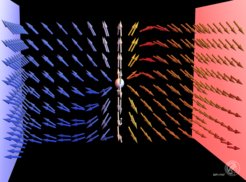Magnets with chiral crystal structure are identified as a new class of topological materials
Magnetic screw rotations lead to 2D topological band degeneracies crossing the Fermi level
Topological quantum materials exhibit unusual electric properties, such as conducting surface states and anomalous Hall phenomena, that are unaffected by deformations, e.g., stretching, compressing, or twisting of the material, or adding disorder. This makes this class of materials promising for applications in spintronics and future post-silicon devices. Particularly interesting are topological semimetals, where these properties arise due to crossings of the electronic bands. At these crossings the electronic bands have a degeneracy which is of topological origin, i.e., it carries a quantized Berry flux or Berry phase and is, to some extent, topologically protected against deformations and disorder. The topological band degeneracies may occur at single points, as in Dirac or Weyl semimetals, or along one-dimensional lines, as in nodal-line semimetals. When these degeneracies occur in a material near the top of all filled electronic states (i.e., at the Fermi level), the electronic responses inherit the topological character, leading, for example, to robust anomalous Hall effects, which scale with the magnitude of the Berry flux. However, in general these zero- or one-dimensional band degeneracies do not occur at the Fermi level, such that the topological responses are suppressed.

In a new study, published in Nature, a team of scientists at the Max Planck Institute for Solid State Research and at the TU Munich, show that a large class of magnets with chiral crystal structure exhibits two-dimensional (2D) band degeneracies in its electronic structure with nontrivial topology. In these materials, the combination of screw rotations with time-reversal symmetry (i.e., magnetic screw rotations) gives rise to symmetry-enforced band crossings on 2D planes at the boundary of reciprocal space. These 2D band degeneracies are sources of Berry flux, which is absorbed by a single Weyl point at the origin of reciprocal space (Fig. 1). The intersection of the 2D crossings with the Fermi level generically leads to 1D degeneracies of the topmost filled electronic states (i.e., of the Fermi surfaces), where the Berry flux becomes extremal. Hence, these materials exhibit large electronic responses of topological origin, which is enhanced due to the large separation of sources and sinks of Berry flux. These responses are robust against deformations and shifts of the Fermi level, by, e.g., impurity doping. Moreover, this class of magnets features topological surface states, which span about half of the surface reciprocal space, leading to large surface conductance.
From a detailed symmetry analysis the researchers establish that 33 space groups support 2D topological band degeneracies, including the space group of ferromagnetic MnSi. Using de Haas–van Alphen spectroscopy they demonstrate the existence of topological band degeneracies at the Fermi level of MnSi. Other materials with 2D topological band degeneracies include the magnets CoNb3S6 and Nd5Si3, as well as the paramagnets CoSi and PdGa. The topological degeneracies of this class of materials can be easily controlled by an applied magnetic field, which can induce huge changes in the Berry flux, and hence of the associated topological responses. These properties may be harnessed for technological applications, such as ultrasensitive detectors, and await to be explored both from a fundamental and applications point of view.











